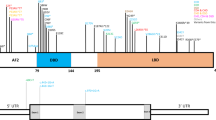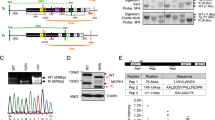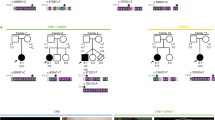Abstract
The aetiology of spina bifida involves genetic and environmental factors, which may be why major genes contributing to pathogenesis have not been identified. Here we report that undulated–Patch double–mutant mice have a phenotype reminiscent of an extreme form of spina bifida occulta in humans. This unexpected phenotype in double–mutant but not single–mutant mice shows that novel congenital anomalies such as spina bifida can result from interaction between products of independently segregating loci. This example of digenic inheritance may explain the often sporadic nature of spina bifida in humans.
This is a preview of subscription content, access via your institution
Access options
Subscribe to this journal
Receive 12 print issues and online access
$209.00 per year
only $17.42 per issue
Buy this article
- Purchase on Springer Link
- Instant access to full article PDF
Prices may be subject to local taxes which are calculated during checkout
Similar content being viewed by others
References
Copp, A.J. et al. The embryonic development of mammalian neural tube defects. Prog. Neurobiol. 35, 363–403 (1990).
Elwood, J.M., Elwood, J.H. & Little, J. Classification, anatomy and embryology. in Epidemiology and Control of Neural Tube Defects (eds Elwood, J. M., Little, J. & Elwood, J.H.) 10–36 (Oxford University Press, Oxford, 1992).
Essien, F.B., Haviland, M.B. & Naidoff, A.E. Expression of a new mutation (Axd) causing axial defects in mice correlates with maternal phenotype and age. Teratology 42, 183–194 (1990).
Epstein, D.J., Vekemans, M. & Gros, P. Splotch (Sp2H), a mutation affecting development of the mouse neural tube, shows a deletion within the paired homeodomain of Pax-3. Cell 67, 767–774 (1991).
Strong, L.C. & Hollander, W.F. Hereditary loop-tail in the house mouse accompanied by imperforate vagina and craniorachischisis when homozygous. J. Hered. 40, 329–334 (1949).
Neumann, P.E. et al. Multifactorial inheritance of neural tube defects: localization of the major gene and recognition of modifiers in ct mutant mice. Nature Genet. 6, 357–362 (1994).
Estibeiro, J.P. et al. Interactions between splotch (Sp) and curly tail (ct) mouse mutants in the embryonic development of neural tube defects. Development 119, 113–121 (1993).
Ehlers, K. et al. Valproic acid-induced spina bifida: a mouse model. Teratology 45, 145–154 (1992).
Alles, A. & Sulik, K.K. Retinoic acid-induced spina bifida: evidence for a pathogenetic mechanism. Development 108, 73–81 (1990).
Balling, R., Deutsch, U. & Gruss, P. undulated, a mutation affecting the development of the mouse skeleton, has a point mutation in the paired box of Pax-1. Cell 55, 531–535 (1988).
Wallin, J. et al. The role of Pax-1 in axial skeleton development. Development 120, 1109–1121 (1994).
Morrison-Graham, K. et al. A PDGF receptor mutation in the mouse (Patch) perturbs the development of a non-neuronal subset of neural crest-derived cells. Development 115, 133–142 (1992).
Orr-Urtreger, A. et al. Developmental expression of the alpha receptor for platelet-derived growth factor, which is deleted in the embryonic lethal Patch mutation. Development 115, 289–303 (1992).
Schatteman, G.C. et al. Regulation and role of PDGF receptor alpha-subunit expression during embryogenesis. Development 115, 123–31 (1992).
Stephenson, D.A. et al. Platelet-derived growth factor receptor alpha-subunit gene (Pdgfra) is deleted in the mouse patch (Ph) mutation. Proc. natn. Acad. Sci. U.S.A. 88, 6–10 (1991).
Nagel, D.L. et al. Structural analysis of chromosomal rearrangements associated with the developmental mutations Ph, W19h, and Rw on mouse chromosome 5. Proc. natn. Acad. Sci. U.S.A. 91, 7237–7241 (1994).
Brunkow, M.E. et al. A 1.8 Mb YAC contig spanning three members of the receptor tyrosine kinase gene family (Pdgfra, Kit and FIk1) on mouse chromosome 5. Genomics (in the press).
Grüneberg, H. Genetical studies on the skeleton of the mouse. II. Undulated and its ‘modifiers’. J. Genet. 50, 142–173 (1950).
Grüneberg, H. Genetical studies on the skeleton of the mouse. XII. The development of undulated. J. Genet. 52, 441–455 (1954).
Koseki, H. et al. A role for Pax- 1 as a mediator of notochordal signals during the course of dorsoventral specification of vertebrae. Development 119, 649–660 (1993).
Chalepakis, G. et al. The molecular basis of the undulated/Pax-1 mutation. Cell 66, 873–884 (1991).
Grüneberg, H. & Truslove, G.M. Two closely linked genes in the mouse. Genet. Res. 1, 69–90 (1960).
Dimmerick, J.E. Developmental Pathology. (J. Wiley, New York, 1992).
Besmer, P. et al. The kit-ligand (steel factor) and its receptor c-kit/W: pleiotropic roles in gametogenesis and melanogenesis. Devel. Suppl. 1993, 125–137 (1993).
Duttlinger, R. et al. The Wsh and Ph mutations affect the c-kit expression profile: c-kit misexpression in embryogenesis impairs melanogenesis in Wsh and Ph mutant mice. Proc. natn. Acad. Sci. U.S.A. 92, 3754–3758 (1995).
Marin-Padilla, M. Cephalic axial skeletal and neural dysraphic disorders: embryology and pathology. Can. J. Neurol. Sci. 18, 153–169 (1991).
Takahashi, Y. et al. A role for Quox-8 in the establishment of the dorsoventral pattern during vertebrate development. Proc. natn. Acad. Sci. U.S.A. 89, 10237–10241 (1992).
Lykken, D.T. Research with twins: the concept of emergenesis. Psychophysiology 19, 361–373 (1982).
Li, C.C. A genetical model of emergenesis: in memory of Laurence H. Snyder, 1901–1986. Am. J. hum. Genet. 41, 517–23 (1987).
Kajiwara, K. et al. Digenic retinitis pigmentosa due to mutations at the unlinked peripherin/RDS and ROM1 loci. Science 264, 1604–1608 (1994).
Schork, N.J. et al. Two-trait-locus linkage analysis: a powerful strategy for mapping complex genetic traits. Am. J. hum. Genet. 53, 1127–1136 (1993).
Lander, E.S. & Schork, N.J. Genetic dissection of complex traits. Science 265, 2037–2048 (1994).
Knapp, M. et al. Two-locus disease models with two marker loci: the power of affected-sib-pair tests. Am. J. hum. Genet. 55, 1030–1041 (1994).
Dizier, M.-H. et al. Interactive effect of two candidate genes in a disease: extension of the marker-association-segregation X2 method. Am. J. hum. Genet. 55, 1042–1049, (1994).
Miller, S.A., Dykes, D.D. & Polesky, H.F. A simple salting out procedure for extracting DNA from human nucleated cells. Nucl. Acids Res. 16, 1215 (1988).
Author information
Authors and Affiliations
Rights and permissions
About this article
Cite this article
Helwig, U., Imai, K., Schmahl, W. et al. Interaction between undulated and Patch leads to an extreme form of spina bifida in double-mutant mice. Nat Genet 11, 60–63 (1995). https://doi.org/10.1038/ng0995-60
Received:
Accepted:
Issue Date:
DOI: https://doi.org/10.1038/ng0995-60
This article is cited by
-
Modifier genes in mice and humans
Nature Reviews Genetics (2001)
-
Promoter haplotype combinations of the platelet-derived growth factor α-receptor gene predispose to human neural tube defects
Nature Genetics (2001)



